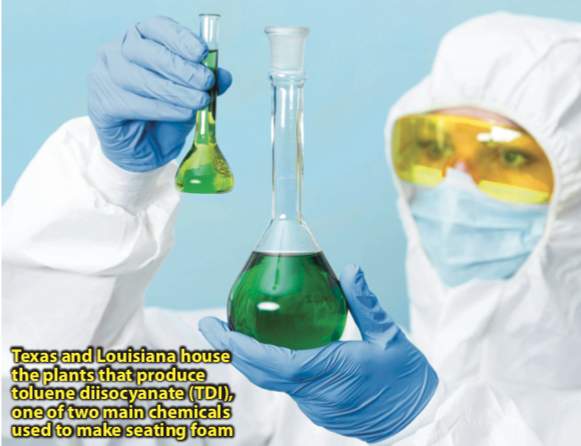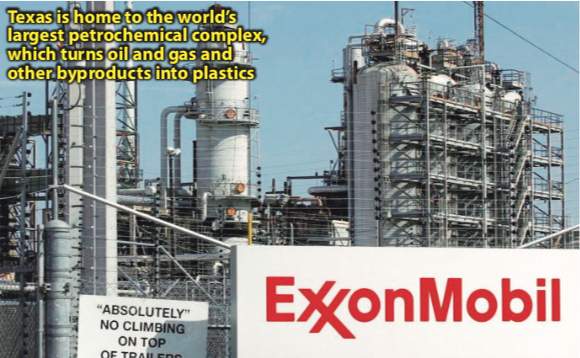Plastics and Chemicals Shortage, the New Challenge for Automakers

By Nancy J. Gonzalez
The automotive supply chain has been disrupted for a while now. The COVID-19 pandemic made automakers aware of the high dependence the industry has on Asian components and raw material. Moreover, the recent chip shortage forced automakers in North America to temporarily shut down operations or reduce their production.
Now, automakers are facing a new challenge: the plastics and chemicals shortage. Even though it has been months since the winter storms and power outages hit Texas and Louisiana in mid-February, their economic impact, particularly for the automotive industry, is still being felt greatly around the U.S. Experts said it will take more than six months to correct the imbalances caused by the storm.
Texas and Louisiana house the plants that produce toluene diisocyanate (TDI), one of two main chemicals used to make seating foam. These two states account for most of the key chemical inputs for foam production. The storm forced several U.S. Gulf Coast chemical plants to shut down their manufacturing process for several weeks, hitting production.
Moreover, Texas shut down a refinery that feeds production of 85% of resins produced in the U.S. Those resins go into components from car bumpers to steering wheels. Moreover, in August, Hurricane Laura forced a number of petrochemical factories in Louisiana and Texas to shut down; overnight 10% to 15% of U.S. polyethylene (PE), polypropylene (PP) production stopped.
Texas is home to the world’s largest petrochemical complex, which turns oil and gas and other byproducts into plastics. Almost 100 critical chemicals and derivatives used widely across many products and industries are processed in Texas.
Even though these chemicals and plastics are some of the least expensive raw materials in a vehicle, they are used to make many components and they are as important as any other auto part, since clients want to buy fully equipped vehicles, not just a part of it.
Other components used to make seat foam include Polyether Slabstock, HR/CMHR Slabstock, Polyester Slabstock, Viscoelastic Foam, Moulded Foam. Also, methylene diphenyl diisocyanate (MDI) is a key raw material for polyurethane, which is used in numerous fields such as auto parts and seating for cars.
Constraints on the supplies of their raw materials—especially PE, PP, and mono-ethylene glycol (MEG)—are leading to factory shutdowns, sharp price increases, and production delays across a range of industries.
“Many supply chain managers failed to adequately monitor polymer suppliers because those materials go into low-cost items like adhesives and resins. While they’re widely used across many products, their low cost meant they were not top of mind at many companies. To build a more resilient supply chain, it’s vital to look at even the most inexpensive parts and materials when they are critical to products and revenues and not just expensive, sophisticated, or specialty items,” wrote Bindiya Valkil in a recent Harvard Business Review article.
The automotive and the furniture industries have been struggling to get seat foam for a while now due to the imbalance between strong consumer demand and available materials.
As a way to temporary solve this plastic and chemicals shortage, some suppliers are flying in resin to the U.S. from Europe, but the cost of this raw material increases exponentially using this kind of transportation.
Containers are other alternative to bring to the U.S. for the missing raw material, but some challenges must be faced too. Containers and boats to ship product from overseas are also in short supply because of the high demand. Product could be sitting in a factory overseas for months because it cannot get into a ship. The unavailability of ocean containers has been an issue for almost a year. Also, the blocking of the Suez Canal by a container ship was another logistic burden.

In her article, Valkil said COVID-19 vividly revealed the vulnerabilities baked into lean, costoptimized supply chains.
“It also highlighted the need for building supply-chain-resilience capabilities. During the pandemic, companies that had solid monitoring and supplier mapping capabilities— down to the sub-tier site and part level—had a complete picture of how the evolving crisis would affect their supply chains,” Valkil wrote. “This helped companies take action before the disruption hit, and some were able to avert any negative impact.”
Most automakers increasingly rely on single suppliers as supply chains get more global. For some, this can fuel the crisis.
Carlos Tavares, the chief executive of Chrysler parent Stellantis, said in a March interview that the company estimated it bought about 400,000 parts for the 100 models in the lineups of Chrysler, Ram, Fiat, Peugeot and other brands. He said some 95% of those parts come from a single source.
“That’s the norm in the automotive industry,” Tavares expressed.

Experts said dual sourcing is another strategy that might pay off. That means maintaining one’s primary, cost-effective supplier but also cultivating a relationship with a more regional supplier, even if it means paying a higher price. The practice can act as a sort of insurance policy if the primary supplier is suddenly no longer available.
Moreover, the shift to electric vehicles is adding pressure on automakers to rethink their automotive history, because EV make heavy use of parts in the shortest supply, including lithiumion batteries and semiconductors.
A recent Wall Street Journal headline said: “Everywhere You Look, the Global Supply Chain Is a Mess,” and for automakers the recent challenges have been hard to overcome. For many, this situation will continue for a year, while some companies are rethinking their business models.